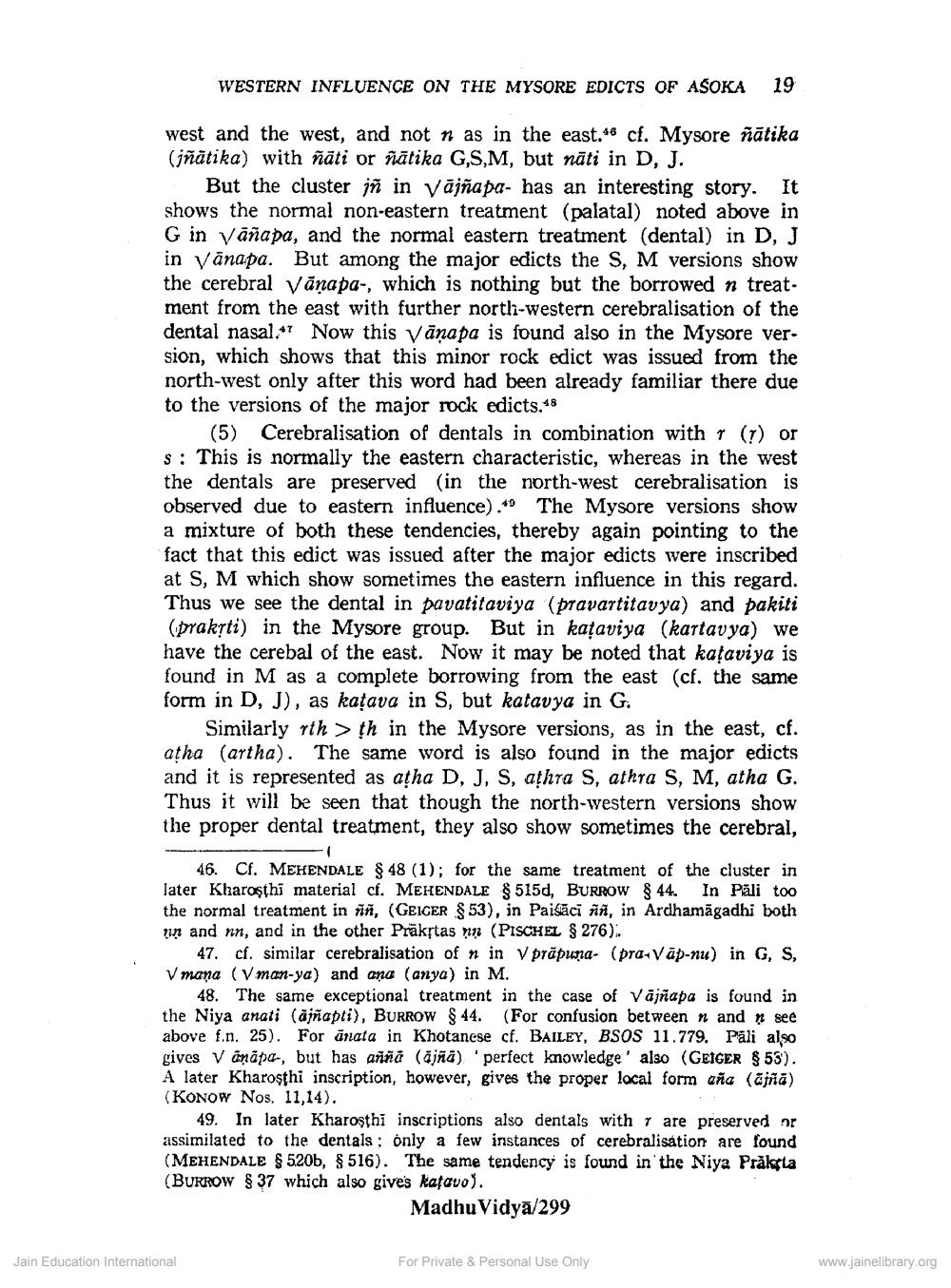________________
WESTERN INFLUENCE ON THE MYSORE EDICTS OF ASOKA 19
west and the west, and not n as in the east. cf. Mysore ñātika (jñātika) with ñati or nätika G,S,M, but näti in D, J.
But the cluster in in Väjñapa- has an interesting story. It shows the normal non-eastern treatment (palatal) noted above in G in Vañapa, and the normal eastern treatment (dental) in D, J in yanapa. But among the major edicts the S, M versions show the cerebral Vanapa-, which is nothing but the borrowed n treatment from the east with further north-western cerebralisation of the dental nasal. Now this Vanapa is found also in the Mysore version, which shows that this minor rock edict was issued from the north-west only after this word had been already familiar there due to the versions of the major rock edicts.48
(5) Cerebralisation of dentals in combination with (7) or s This is normally the eastern characteristic, whereas in the west the dentals are preserved (in the north-west cerebralisation is observed due to eastern influence). The Mysore versions show a mixture of both these tendencies, thereby again pointing to the fact that this edict was issued after the major edicts were inscribed at S, M which show sometimes the eastern influence in this regard. Thus we see the dental in pavatitaviya (pravartitavya) and pakiti (prakṛti) in the Mysore group. But in kajaviya (kartavya) we have the cerebal of the east. Now it may be noted that kafaviya is found in M as a complete borrowing from the east (cf. the same form in D, J), as kaṭava in S, but katavya in G.
Similarly rth >th in the Mysore versions, as in the east, cf. atha (artha). The same word is also found in the major edicts and it is represented as atha D, J, S, athra S, athra S, M, atha G. Thus it will be seen that though the north-western versions show the proper dental treatment, they also show sometimes the cerebral,
J
46. Cf. MEHENDALE § 48 (1); for the same treatment of the cluster in later Kharoşthi material cf. MEHENDALE § 515d, BURROW § 44. In Pali too the normal treatment in ññ, (GEIGER $53), in Paisaci ññ, in Ardhamāgadhi both un and nn, and in the other Präkṛtas nn (PISCHEL § 276).
47. cf. similar cerebralisation of n in Vprapuna- (pra-Vap-nu) in G, S, V mana (Vman-ya) and ana (anya) in M.
48. The same exceptional treatment in the case of Vajñapa is found in the Niya anati (ajñapti), BURROW § 44. (For confusion between n and see above f.n. 25). For anata in Khotanese cf. BAILEY, BSOS 11.779. Pāli also gives V aṇāpa, but has añña (ajñā) 'perfect knowledge' also (GEIGER §53). A later Kharoşthi inscription, however, gives the proper local form aña (ajñā) (KONOW Nos. 11,14).
49. In later Kharoşthi inscriptions also dentals with are preserved or assimilated to the dentals; only a few instances of cerebralisation are found (MEHENDALE § 520b, § 516). The same tendency is found in the Niya Prakta (BURROW § 37 which also gives katavo).
Madhu Vidya/299
Jain Education International
For Private & Personal Use Only
www.jainelibrary.org




